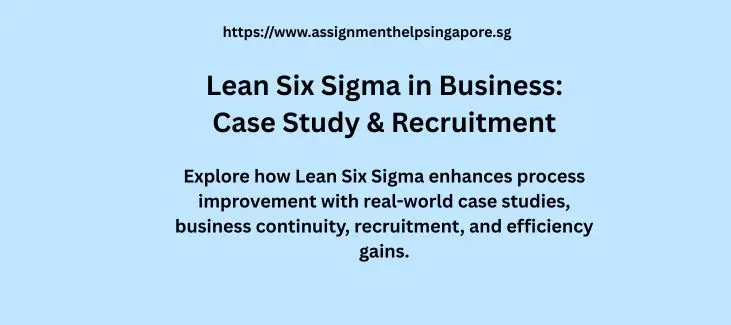
Contents
BUS366 Lean Six Sigma Tutor-Marked Assignment
Question 1
Case Study
Many businesses are facing significant disruptions due to geopolitical tensions, market volatility, shifting consumer behaviour, and rapid technological advancements. These challenges have compelled companies to reassess their operational strategies to ensure business continuity and survival. Lean Six Sigma is a proven methodology that has been effectively utilised to enhance processes across various industries. Appraise the application of this methodology in process improvement and provide a case summary of its successful implementation in an organisation/industry you are familiar with. The selected company must be real, and you are to include its physical address and website information. Present a case study summary to address the following aspects of your selected organisation/industry:
(a) A brief overview of the organisation/industry and its challenges.
(b) The Lean Six Sigma objective/approach undertaken and the major steps in the methodology implemented for improvement. You are to connect your analysis to the processes identified in the case study, focusing on the application of Lean, Six Sigma, or Lean Six Sigma in the improvement project. Any improvement approaches or tools related to these methodologies are acceptable.
(c) The results achieved from process improvements, and a quick summary of lessons learned from the case study.
Your case study should be based on information from reliable sources, such as industry reports, peer-reviewed journal articles, or recognised publications of reputable organisations. You must provide the source of information, in-text citations, references in an end-text reference list if the case study is from external sources. Indicate the word count at the end of your response. Present your answers addressing each aspect as indicated above. (Word limit: 500) (60 marks)
Question 2
Improving the Recruitment Process A major Education Group offering enrichment courses, relatively new to the Singapore market, is looking to increase its staffing to support the surge in demand for business. However, past recruitment efforts by the Group have revealed that previous attempts to increase headcount elsewhere have been met by unsuccessful outcomes due to the lengthy hiring process. The Group CEO, Mr. Lucas, has decided to task you (Lean Six Sigma Team Lead) to improve the recruitment process to yield a reduction in the average time taken to hire staff by at least 30% in three months starting 1 August 2025.
(a) Recommend a suitable project objective. Discuss the VOC and define the CTQ (Project Y) for this project. (10 marks)
(b) Develop a SIPOC diagram for the recruitment process in this Education Group (make reasonable assumptions where necessary). Examine the key factors [at least three (3)] that would affect the speed of the recruitment process. (Word limit: 200) (25 marks)
(c) Identify and evaluate how Singapore, being a relatively new market for the business, may have introduced a different set of challenges, and what you, as the Lean Six Sigma TeamLead, would do differently to overcome these identified challenges. (Word limit: 200) (5 marks)
Operations Management Answers: Experts Answer on Above Operations Management Questions
Overview of challenges
The organization that is selected for the purpose of analysis is Toyota Motor Corporation Singapore. The challenges facing the organization include significant change in the supply chain disruptions, high fluctuation in demand, and operational inefficiency in checking the quality.
Lane Six sigma objective and approach
The main objective has been to achieve reduction in the production defects and cycle time.
The methodology applied: The methodology considered is DMAIC which stands for define, measure, analyze, improve and control. In terms of definition, there is a high defect rate identified in the assembly line, whereas the measurement indicates a high defect rate. The root cause analysis is identified as operational inefficiency whereas the improvement identified is in terms of standardizing the procedure, and control includes continuous monitoring of the process to achieve operational efficiency and lower defect rate.
Results and lessons
The results indicate that there has been a decline in the defect rate by 40% and lead time is reduced by 20% which leads to improved customer satisfaction. The lessons learned is to perform regular monitoring of the process in achieving operational efficiency, including employees in all the decision making process and ongoing monitoring is crucial for battery productivity.
Improving recruitment process
Objective of the project : The project objective has been to reduce the average hiring time by 30% within a period of 3 months. Fasten hiring is what management as well as the candidates expect and the critical to quality would be the average number of days it takes in hiring a candidate.
SIPOC Diagram
The SIPOC analysis includes suppliers such as the hiring managers, HR staff etc and the input is resumes and job requirements. The process would be to post the job and ask applicants to apply for the post, conduct interviews, provide job offers and onboarding. The output would be the selection of the right candidate, and the customers are the candidates applying for the job.
Challenges in Singapore market conditions and Solutions
The main challenges include the higher competition level for talent acquisition in the Singaporean market, and the recognition of the brand is low in the new market. The solution would be to build strong employer branding and partner with local recruitment agencies to hire new staff.
| Disclaimer: This answer is a model for study and reference purposes only. Please do not submit it as your own work. |




